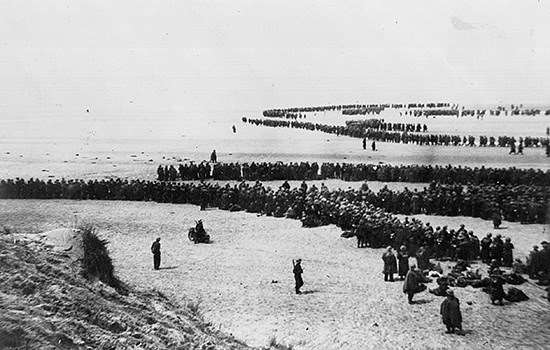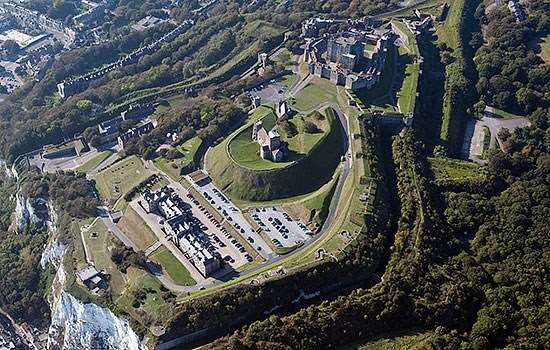The Phoney War
Britain and France entered the Second World War following the German invasion of Poland in September 1939. In expectation of a German advance westwards, the British Expeditionary Force (BEF), which grew to 390,000 men over the winter of 1939–40, deployed alongside the troops of its allies in France and Belgium.
There was a brief French advance into the Saar region of western Germany in September 1939, followed by withdrawal. For the rest of the winter, the Allies dug in along the borders facing their opponents, but there was no fighting. This period of anticipation became known as the ‘Phoney War’.
Denmark and Norway
Fighting began in the spring of 1940, but not in France or Belgium. German forces invaded Denmark and Norway on 9 April with the dual objective of safeguarding their iron ore supplies from Sweden, which shipped out of Norwegian ports, and preventing the Royal Navy from controlling the North Atlantic by blockading German shipping in its own ports.
Denmark surrendered on the day it was invaded. British and French troops fought briefly in Norway, but engaged too late. By 10 June the country had fallen fully under German control.
However, at Narvik in northern Norway, warships of the Royal Navy took a heavy toll on the ships of the German Kriegsmarine (navy). This ensured that, in the long term, the Kriegsmarine was unable to contest control of the North Sea and the English Channel. It also meant that in the short term their contribution to the battle that followed further south in north-west Europe, especially in the evacuations from Dunkirk and elsewhere, was small.
German strategy
Although Adolf Hitler had hoped that France and Britain would not enter the war, he had developed a military strategy for the eventuality. This envisaged a rapid German attack into the Netherlands, Belgium and Luxembourg to prevent the Allied army having a clear route into Germany, especially the vital industrial heartland of the Ruhr. If the attack penetrated as far as the Atlantic coast, it would also provide air and sea bases for military operations against Britain.
The tactical elements of the plan, and its chances of success, were hotly debated among senior German officers. Nevertheless, those in favour won the argument and Hitler authorised the plan. The Phoney War became a real war on 9 May 1940 when the German armed forces mobilised.
Their battle plan consisted of two major military operations – Fal Gelb (‘Case Yellow’) followed by Fal Rot (‘Case Red’). To the surprise of most German commanders, both went largely according to plan.
Blitzkrieg
The German attack on north-west Europe used risky but well thought out tactics. Blitzkrieg, or ‘lightning war’, involved striking with overwhelming force in a crucial location (the Schwerpunkt, or ‘centre of gravity’). This was quickly followed by more attacks from fast-moving tanks, artillery, infantry and aircraft, with the aim of surrounding enemy troops in a zone or Kessel (cauldron), causing their destruction or surrender.
The key element of Blitzkrieg was disorientation, to stop the enemy from reorganising and counterattacking. The inherent risk was that Allied forces might cut through the extending German lines of communication. However, the Allies were so outmanoeuvred and confused that they were unable to act in unison, allowing the Germans to surround and destroy them piecemeal, or cause continuous retreat.
Superior German communications aided this style of warfare – even the smallest field units were equipped with radios that allowed them to move and react faster than the Allies. The close coordination of German air and ground forces, to produce maximum destructive firepower, was also significant.
The German advance
Case Yellow’s objective was to entice the main Allied forces into northern France and Belgium, and to surround them in a huge ‘pincer’ manoeuvre. The northern arm of the pincer saw German forces advance through the Netherlands and Belgium on the 10th.
But this attack, though formidable, was in reality a diversion. It had the desired effect of drawing the main and best Allied forces north to meet it. The Netherlands, a declared neutral country, was quickly overrun and surrendered on 15 May.
Meanwhile, also on the 10th, the massive southern arm of the pincer struck through Luxembourg and into Belgium. Having advanced through the heavily forested Ardennes – a region considered impossible for a large force to cross quickly – this main German force fought its way across the river Meuse at Sedan on 13 May.
The attack punched through the defending French forces and proceeded to race across northern France, causing confusion and disarray. With no strategic Allied reserve or counterattack of any strength to stop them, German advance forces reached the English Channel near Abbeville, at the mouth of the river Somme, just a week later.
The pincer movement trapped Dutch, French, Belgian and British forces between the two German army groups and proceeded to squeeze them into an ever-decreasing pocket in northern France and Belgium, against the coast. Unless an effective counterattack could be made, the only escape for Allied forces was by sea, through the ports of Boulogne, Calais, Dunkirk and Ostend. Millions of civilians were caught up in the fighting.
An Allied counterattack at Arras was briefly successful but failed because it had insufficient forces behind it. Otherwise, the tide could not be turned and the Allied forces were in disarray. They were unable to react quickly enough to reorganise against the much more rapidly evolving and responsive German attacks.
By 26 May, all the French and Belgian ports north of the river Somme, apart from Dunkirk, had been captured. Belgium surrendered on 28 May, and Case Yellow had succeeded by 4 June.
Operation Dynamo, 26 May – 4 June 1940
By the last week of May 1940, most of the BEF, a large French contingent and some Belgian soldiers were trapped by the German army in a small area around Dunkirk. Their evacuation by sea was imperative, but assessments of success were gloomy.
On the evening of 26 May an amphibious rescue, codenamed Operation Dynamo, was set in motion. It was controlled by the Royal Navy command in Dover, under Vice-Admiral Bertram Ramsay, from his headquarters in Dover Castle.
Over the next nine days, the Royal Navy’s fighting ships, merchant transport vessels and small civilian boats of all kinds plied the dangerous waters to and from Dunkirk under frequent and intense German attacks from land, sea and air.
Over 900 vessels in all took part in the evacuation. Some ferried troops from the beaches to larger ships offshore, while big vessels loaded directly from a flimsy breakwater – the east mole – in Dunkirk’s outer harbour.
Under ferocious German attack, British, French and Belgian troops defended Dunkirk while the Royal Navy’s fighting ships and its hastily assembled fleet of merchant and civilian ships and boats loaded more and more troops, despite many ships being sunk and many lives lost. The operation came to a close in the early hours of 4 June. By the end of the day, 338,226 British and Allied troops had been rescued and landed in England.
The rescue has been described as a ‘miracle’ and remains the largest amphibious evacuation undertaken in any wartime conditions. It enabled the British Army to regroup and fight again.
More about Operation Dynamo
France Falls
However, Luxembourg, the Netherlands and Belgium had fallen, and France was to be next.
The German Army now quickly moved to initiate Case Red. This saw German forces strike south into the heart of France, with the intention of taking Paris. It began on 5 June with an attack across the Somme and Aisne rivers, heading into north central and west central France. At the same time, a separate force attacked the Maginot Line – the powerful fortifications on France’s eastern border – from the French side. This second attack prevented French troops on the Maginot Line from reinforcing those defending against the German attack on Paris.
Despite fierce fighting, the loss of so many Allied troops and so much equipment in Case Yellow meant that the Germans gradually gained the upper hand over the French Army and the remaining British force – more British and Canadian troops were sent after Dunkirk. The Maginot Line fortresses fell one by one, though some held until July. Meanwhile the main attacks across the Somme and Aisne, initially checked by the French, eventually broke through, and succeeded in taking Paris on 14 June.
On 22 June the French signed an armistice, surrendering to the Germans. France had fallen.
Aftermath
The rapid German advance left many Allied soldiers in danger of capture. Further amphibious evacuations, Operation Cycle and Operation Aerial, between 10 and 25 June resulted in another 192,000 troops (British, Canadian, French, Polish and Czech) and civilians being rescued and taken to safety by the Royal Navy from ports in Brittany and western France.
Many also lost their lives, including those at sea aboard HMT Lancastria, which was sunk off Saint-Nazaire by German aircraft. Between 3,000 and 6,000 people are thought to have died, the worst naval disaster in British history. Elsewhere, thousands were left behind, including over 10,000 men of the 51st Highland Division, who became prisoners of war.
The terms of the Armistice allowed the southern half of France, except the extreme south-east (which was occupied by Germany’s ally, the Italian Army) and the Atlantic seaboard, to remain under French civil administration. France also retained her colonies in North Africa and elsewhere, but in every other respect France became a puppet state of Germany. The new French government was based on the city of Vichy in central France. But in late 1942 it effectively lost power when German and Italian forces took over, after the Allies invaded North Africa, to safeguard southern France.
The liberation of France had to wait almost two more years, following the Allied invasion of Normandy in June 1944.
By Paul Pattison
Top image: German tanks advancing through difficult terrain in the Belgian Ardennes, May 1940 (© ullstein bild/Getty Images)
Find out more
-

Operation Dynamo: Things You Need to Know
Find out the key facts about Operation Dynamo, the near-miraculous evacuation from Dunkirk in 1940, which was controlled from Dover Castle.
-

History of Dover Castle
Learn about the long history of the castle, from its likely origins as an Iron Age hillfort, through its development as a great fortress, to its secret role in the Cold War.
-

Dunkirk on the Home Front
Read some of the personal stories of what it was like to work in the tunnels beneath Dover Castle during the Dunkirk evacuation in 1940.
-

Dover on the Front Line
This guidebook tells the story of how a network of tunnels beneath Dover Castle played a vital role in the Second World War.
